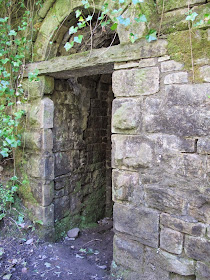Mellor Mill before it burned out
Eight of us, members of Wilmslow Local History Group, today visited the site of mill entrepreneur Samuel Oldknow's Mellor Mill. We enjoyed a fascinating morning being shown around the site by Bob Humphrey-Taylor, who visited our group in November dressed in character as Samual Oldknow (see the blog at Open day at Marple Locks).
Bob as Samuel Oldknow at Marple locks last year
The morning was topped off by a pleasant al fresco lunch at The Midland in Marple Bridge. The warm sun sparkled on the fast flowing adjacent River Goyt (which powered Oldknow's mill), the river's subdued roar providing a pleasant background to our conversation.
Some information on Samuel Oldknow and his mill. As with any picture here please click on it to make it larger.
We parked on the Strines road and walked down off the ridge to cross the River Goyt at Roman Bridge. It isn't Roman but was built as a packhorse bridge in the 1700s.
Running next to the river is this road, built by Samuel Oldknow and intended to be the main turnpike. It never developed beyond the unmetalled track it remains today. The Strines road along the ridge top became the turnpike instead. Here Mike, who founded the Group, discusses with Bob, our guide, the technique used in building this.....
.....The railway viaduct over the Goyt. And Oldknow's failed turnpike road.
The 'turnpike' toll house
The wier, above which water is taken from the river along a leat to the first mill pond. There are three mill ponds at Mellor; two the river valley fed by the river, and one higher up in the hills fed by streams. When the mill burned out in 1892 a lot of people lost their jobs, including the mill manager. Being an enterprising sort, he turned the two lower mill ponds into leisure lakes, naming them 'Roman Lakes', a name they retain to this day. Roman Lakes became a popular weekend 'resort' especially when the railway arrived at Marple, a short distance away, enabling people to travel from a wide area to visit the attraction.
Bottoms Hall became the Apprentice House for the mill, where mill apprentices were housed.
In the 1920s the remains of the mill were demolished and the rubble filled the basement areas. The first job the archaeologists had to was to excavate the site, a task which is ongoing. Here is the wheel pit of the Wellington Wheel in the mill basement. Like the wheel at Styal it was a breast-shot suspension wheel, with the drive taken off at the rim, not the axle. It was 17 feet wide and 22 feet in diameter. The Great Wheel at Quarry Bank is 32 feet in diameter and 21 feet wide.
The diagram on the plan on this information board (click on the picture to enlarge it) shows the three wheels at Mellor. The Wellington in the mill basement, the Corn Mill wheel in the southern wheel house, and the later Waterloo Wheel which was housed in an external building and driven by the combined tail races of the first two wheels. Power from this wheel was conveyed tom the mill by shafts running in underground tunnels.
Bob stands on the area in front of the mill which used to be beneath the entrance hall. It was a 2-horse stable for 'servicing' the horses of important visitors to the mill.
The northern section of the mill is still being excavated. The mill was six stories tall, but only 33 feet front to back. This was typical for cotton mills, and allowed two rows of machines each by a window on an external wall (for light), and a central aisle. The small arched brick culvert centre left are for ventilation, carrying heated damp air from the wheel chamber along each 'wing' of the mill, and up to each floor. A warm damp environment was essential for cotton spinning.
This is where the tail races of the Wellington Wheel and the Corn Mill Wheel combine to be fed to drive the Waterloo Wheel in its separate wheel house
Here is the as-yet unexcavated wheel pit for the Waterloo Wheel. Click on the picture to enlarge it and you should be able to see the exit tail race tunnel centre right. After passing over the first two wheels, then used at a lower level to drive the Waterloo Wheel, the water level in this tail race was too low to enter the river. As at Styal, an extended tail race tunnel was dug downstream to a point where the river had descended enough to allow the tail race water to be fed into it.
Oldknow's turnpike bridge over the Goyt. His mansion, Mellor Lodge. was near here on the 'mill' side of the river.
The site has many tunnels. Some of these housed underground drive shafts, some were ventilation tunnels, but this one led from the 'turnpike' bridge to the cellars of Oldknow's house. His servants could carry provisions directly into the cellars through this entrance to a lengthy tunnel system to and under the house.
The weather was superb and we had a most enjoyable morning. A walk back up the Goyt to Roman Bridge and then up the hill to the Strines road brought us back to our cars, and on to that pleasant lunch in Marple bridge.
.

















No comments:
Post a Comment